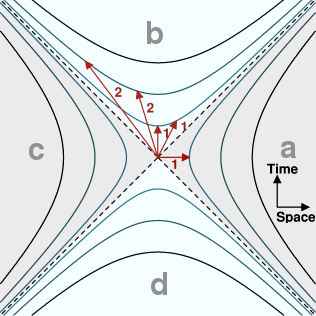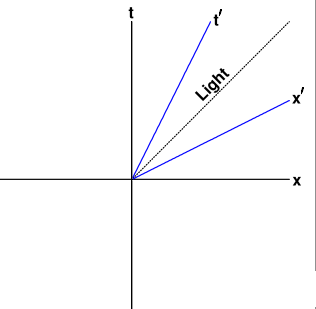 n the latest triumph for Einstein's theory of relativity, astronomers had a collective
spacegasm last month when they detected gravitational waves from 130 million light years
away, close enough to visually identify the source: a kilonova collision of two neutron
stars.
n the latest triumph for Einstein's theory of relativity, astronomers had a collective
spacegasm last month when they detected gravitational waves from 130 million light years
away, close enough to visually identify the source: a kilonova collision of two neutron
stars.
As many people noticed, this event, called GW170817[1], is the strongest evidence yet that gravity travels at the speed of light c. A gamma ray burst was detected within 1.7 seconds of the GW pulse[2] showing that gravity and light travel at almost exactly the same speed: at a distance of 40±8 MPc it means they're the same within 5 parts in 1016, or one part in 2 quadrillion.
Gravitational waves are transverse waves produced by accelerating matter. The effect they have on matter is to alternately compress it in one direction and then the other. This is called a quadrupolar wave, and it is why the LIGO detectors have an L shape.
Shakespeare on relativity If I have mass, do I not gravitate? If you apply force to me, do I not accelerate? —fake Shylock quote from Merchant of VeniceYou can't talk about this without mentioning Einstein. Einstein postulated that the laws of nature, including the speed of light, must be the same for every observer. From this, we are forced to conclude that length, distance, time, space, and mass are no longer constant.
By putting the laws of physics first, Einstein revolutionized our view of the universe, and empirical evidence showed he was right. Other physicists of his day, notably Hendrik Lorentz[3], modified Newton's equations to account for the same results that motivated Einstein (such as the Michelson-Morley result), but as Wolfgang Rindler points out in his book Relativity: Special, General, and Cosmological, these theories were sterile: they might have saved Newtonian mechanics, but they produced no new physics.

Fig. 1 Minkowski diagram. Light always travels at the same speed, shown by the dotted lines. A vertical line means you're standing still. Traveling into the gray areas is impossible. The curved lines represent points that are equal “distances” from the center. As your speed approaches c, that distance changes
Einstein's theory succeeded because he took his axioms at face value—absolutes, as it were—and followed them to their logical conclusion. So in a sense, the Theory of Relativity really should be called the Theory of Absolutivity.
Space and time are different manifestations of the same thing: spacetime. We still don't fully understand this. Perhaps the biggest mystery is this, as Bernard Schutz put it:
Although ‘time’ and ‘space’ can in some sense be transformed into each other in SR, it is important to realize that we can still talk about ‘future’ and ‘past’ in an invariant manner.[4]
The question is: why? Also, what? and how? How do we reconcile the fact that the speed of light is the same for all observers with the fact that gravity can propagate through it? Is there a fixed medium or not?
It is ironic that Einstein's most creative work, the general theory of relativity, should boil down to conceptualizing space as a medium when his original premise [in special relativity] was that no such medium existed. — Robert B. Laughlin
It's tempting to say it's exactly what you'd expect if the universe were a simulation. If I were programming a simulation of a universe, I might cut corners this way. But it's also possible that relativity is telling us something important about the relationship between observers (or maybe even ‘consciousness’) and time.
Why is the speed of light not infinity?
A Bing search on this question leads to many explanations: it's because mass increases, or because an infinite amount of energy would be needed to exceed c, or because it would violate causality, or because light would not propagate. These are all true, but they're just re-statements of the question.
Explaining it in terms of causality, for instance, simply means that cause and effect can't occur faster than c. It doesn't explain why.
Fig. 1 above shows Minkowski's famous diagram of spacetime. It shows how distance changes depending on your reference frame. Instead of circles, the equidistant lines of distance 1, 2, etc. become hyperbolas. The dotted lines at 45° show the light cone of the event at the center, which is to say the direction light would travel. As the arrows approach 45°, they become longer, which means that travelers at the speed of light would think they were covering a vast distance in space in almost no time. (Those fools.)

Fig. 2 The space and time axes of a person in motion (blue lines) are no longer perpendicular from the viewpoint of a person remaining stationary.
Some people (for example, Schutz) interpret the slope of the arrows to be the inverse of speed, so any slope less than 45° (into the gray area) is impossible. Other authors, like Rindler, use a different notation: movement into the blue area is impossible, and real-world particles can only move into the gray areas. This is what's called a Rindler Frame.
Einstein's theory says that space and time are interconverted in such a way as to keep the distance covered by light in a given period the same. At the speed of light, space and time appear the same. So, if you ask “what is time” you're also asking “what is space.”
As your speed approaches c, the time and space axes measured by a stationary observer rotate as shown in Fig. 2. The t′ and x′ axes remain symmetrical around the 45° line. They still appear perpendicular to the person who is moving, but not to someone standing still.
Relativistic effects like length contraction can pose a challenge for quantum gravity. Not even Einstein believed that space is just nothingness. It must be a physical thing in order for light to propagate through it. In loop quantum gravity, space is a quantized physical thing, called a “spin network.” Some physicists theorize that Lorentz contraction, which is the principle that space must contract to keep c constant, must be broken in some way at very small distances.
Physicists tell us that gravity is not a force at all, but a deformation in space. When something falls, it's merely following its trajectory, called a geodesic, in warped space. That's why light, which has no mass, is also affected by gravity.
The concepts in relativity are powerful and can be applied to other phenomena as well. For example, they can help us explain why a charged particle can move in an electric field. But the equations are still only models. Unlike some who make extravagant claims for mathematics being the basis of reality, Rindler is refreshingly honest:
The present result illustrates well the ‘man-made’ character of physical theories. It is really remarkable how the same empirically known orbits can be ‘explained’ by two such utterly different models as Newton's universal gravitation and Einstein's curved spacetime. Nature exhibits neither potentials nor Lorentzian metrics. Yet both these human inventions lend themselves to a description of a large class of observed phenomena.[5]
So in answer to the original question: the equations and the evidence say so, but nobody really knows why.
1. Abbott BP et al. (2017). GW170817: Observation of Gravitational Waves from a Binary Neutron Star Inspiral. https://journals.aps.org/prl/abstract/10.1103/PhysRevLett.119.161101 The gamma ray burst is called GRB170817A. It originated from a star in NGC 4993, a galaxy in Hydra; R.A.=13h09m48.1s, Dec.=−23d22m53s
2. Díaz MC et al. (2017). Observations of the first electromagnetic counterpart to a gravitational wave source by the TOROS collaboration. Astrophys J Lett. arxiv:1710.05844v1.pdf
3. This is the Lorentz Ether Theory, published in 1904, one year before Einstein's famous 1905 paper describing SR.
4. Schutz B (2009). A First Course in General Relativity, 2nd ed. , p.14. An easy to follow but still rigorous textbook with clear explanations. It's highly recommended; one of the few books on the subject that doesn't warp the space-time continuum.
5. Rindler W (2006). Relativity: Special, General, and Cosmological, 2nd ed. , p. 190. This is an outstanding book on relativity. It not only explains the equations, but also their implications, and what evidence supports them.
nov 02, 2017, 5:55 am; edited nov 03, 2017, 6:39 am
